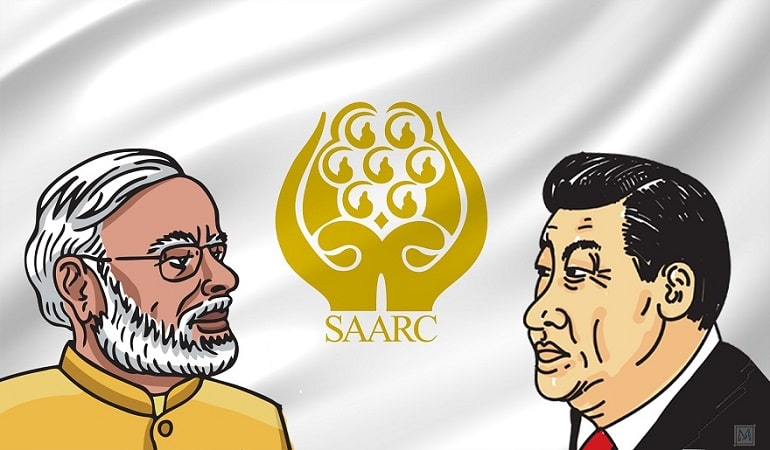Written by : Pratip Chattopadhyay
Photo : shutterstock.com
Snippet:
SAARC is a dead organisation for mainstream analysis in geopolitical and regional studies which is mostly inspired by realist and liberal approach to international politics. For realists the regional body doesn’t have any regional interest vis-a-vis other regions to knit them together and for the liberals the index of conflict among SAARC member-states exceeds that of cooperation and solidarity. From a constructivist perspective however SAARC still has enough reasons to carve out an identity for itself, particularly at a time when China is behaving as the continental power with its BRI (Belt and Road Initiative) project. In this context the present piece tries to understand why and how China’s magnum presence could act as an antidote for SAARC, particularly for building cooperation which is lacking.
Introduction:
Examining the spirit of SAARC in the context of coronavirus pandemic situation can be meaningful in order to make some headway about the future course of this organisation given the stalemate that is there since 2016 with no summit being held till date due to the continuous animosity between Indian and Pakistan in pre-Covid era. However the Covid and post-Covid health requirement and health diplomacy have definitely brought the member countries of SAARC closer to each other than ever before and particularly India and Pakistan have particularly joined hands. Midway through Covid period last year Pakistan was forced to lift the embargo on medicine supply from Indian pharmaceutical companies and this year the brigadier level meet has decided to be in a cease-fire mood across the border. While India is being hailed across the region as a supplier of free vaccines, Pakistan Prime Minister Imran Khan has reportedly been tested Covid positive even after taking a vaccine prepared from Chinese pharmaceuticals. Putting this imagery in a larger context, a pertinent question crops up about the extent to which China can be a reliable friend or aid to SAARC member-countries in comparison to India. In this context the present piece argues that SAARC as a group must understand that this is a high time to regroup themselves a regional unit particularly to resist the silent inroad of Chinese hegemony. Section I indicates the theoretical approach to review the present scenario, section II highlights institutional and practical connections between China and SAARC, section III deals with China-Pakistan and India-SAARC relations and a concluding section argues for a condition in making about regrouping of SAARC keeping in mind Chinese approach of being a pan-Asian superpower, an umbrella like organisation covering all countries and organisation in the region reducing them into redundancy.
Section I
Realist international relation approach, in their classical version talks about human nature and in their neo-realist version talks about anarchical international relation structure as a key driver among actors in world stage to constantly search for power. Even neo-classical realists talks about domestic/internal factors pushing the actors to search for power either by developing own backyard or by bandwagoning. In all these counts SAARC fair poorly. The nature of SAARC member countries is one of animosity and all are eager to surpass other (big brother vs gang up syndrome) in power matrix rather to unitedly search for power. The polemics of international power equations have never bothered the member countries of SAARC to get united but on the contrary have accepted extra regional powers as observer countries and looked up to them for developing power-index. Lastly regarding neo-classical realist prism, SAARC have neither bandwagoned with any regional grouping nor have development internally unitedly. Hence according to realist image SAARC cannot be revitalised by any antidote or immunity booster. The liberal school have always opted for cooperation and coordination within and among regional, sub-regional, international organisations as a key to establish peace in regional and world politics. Peace is something that has been sought after in South Asia with collaborative and cooperative efforts like SAFTA not making much headway in regional economic cohesion. Nevertheless SAARC has always tied to carve out a niche for itself in the developing world forums by their declarations on joint effort in media, environment, health and tourism. However as constructivists school would argue in favour of a socially constructed identity as the key concern of world political actors, SAARC definitely in their own limited way constructed an identity of a developing region but still more needs to be done and a target needs to be identified vis-a-vis whom the regional organisation must create a united identity.
Section II
China is a next door neighbour to SAARC which is the most important player in world politics today militarily and economically. China is on a mission of creating a silent hegemony through its aid diplomacy and BRI project which is known as ‘salami slicing’ act by experts indicating slow intrusion. The contemporary texture of South Asia has transformed from a hotbed of India-Pakistan animosity to India-China animosity, albeit with a difference that for the latter economic cooperation and engagement simultaneously is on a high. So post vaccine health diplomacy period it is upto the member countries of SAARC to chose between a path of knitting together around its own member(India) or extra-reginal observer member(China).
China became a SAARC observer member in 2005. Ever since, it has made significant progress in terms of its participation in South Asian region in the form of unilateral events like China-South Asia business forum, China-South Asia business council, China-South Asia Expo, etc. In 2014, China even nominated an envoy for SAARC, indicating the significance it attaches to this grouping. Moreover, China’s other initiatives like the BCIM Economic Corridor and China-Pakistan Economic Corridor have received positive responses from other SAARC members, if not always from India. In an event not much publicised in India, China, on 15 June, 2018 launched the ‘First China-South Asia Cooperation Forum’ (CSACF) in Yunnan Province. It was also attended by the Indian Consul-General in Guangzhou, Sailas Thangal. The parallel, yet unasked question, either at or outside the CSACF venue, was if the new Chinese initiative, alongside the more-visible Belt and Road Initiative (BRI) could ring the death-knell for the South Asian Association for Regional Cooperation (SAARC), where it had failed to go beyond the ‘Observer’ status, to obtain full membership. CSACF was a part of the BRI, “which is expected to bring together South Asian countries that share a geographical vicinity and cultural affinity with China. Though this was only the first of the CSACF meetings, for five years now, Beijing has been hosting an annual China-South Asia Expo. Other parallel events included the opening ceremony of China-South Asia Poverty Reduction Exhibition, China-South Asia High-Level Round-table Meeting for Business Cooperation, China-South Asia Local Government Leaders’ Dialogue, and a seminar on Financial Cooperation Development Strategy India’s presence and participation at the CSACF, though at the Consul-General level, is at variance from its boycott of the BRI, thus indicating a clear delineation between trade and sovereignty issues. India at least needs to take a closer look at the new Chinese initiative, which comes alongside the BRICS (Brazil, Russia, India, China, South Africa) grouping and the BRI. Among them, the BRICS involves multiple nations, including China and India, with their own political agendas and economic and developmental priorities. In political terms, there is a possibility that through the CSACF, China can make other participant-nations to feel that India is only one of them, and not bigger and more powerful than any or all of them. Given that many of these nations want an ‘eternal friend’ in the UN Security Council, where India is a non-veto, non-permanent member, China has always had an upper hand, even otherwise. These are precisely the kinds of situations that successive Indian governments consciously and Indian consciousness otherwise have been trying to sidestep, before and after the Cold War. This does not mean that India is blind or silent about the CSACF initiative, which like China’s investments drive in the neighbourhood, could bind them eternally to Beijing, as much geo-politically and geo-strategically as it is economically. Given that most of India’s neighbours, barring Bhutan, have joined the BRI, and nations like Maldives have become increasingly hostile, India cannot be but alive to the emerging situation — signing of huge investment deals not only with China but also with Pakistan, alongside Saudi Arabia(Murthy,2018).
Section III
China’s proximity to Pakistan is well known. Nepal is moving closer to China for ideational and material reasons. China is wooing Bangladesh by offering tariff exemption to 97% of Bangladeshi products, and has intensified its ties with Sri Lanka through massive investments. India started investing in other regional instruments, such as BIMSTEC, as an alternative to SAARC. However, BIMSTEC cannot replace SAARC for reasons such as lack of a common identity and history among all BIMSTEC members. Moreover, BIMSTEC’s focus is on the Bay of Bengal region, thus making it an inappropriate forum to engage all South Asian nations. One way to infuse life in SAARC is to revive the process of South Asian economic integration. There are two major domestic challenges that India faces in revitalising SAARC. First, to reap political dividends at home, and for ideological reasons, there has been an unrelenting top-dressing of anti-Pakistan rhetoric and Islamophobia on the Indian soil. There’s also a recurrent use of the ‘Bangladeshi migrant’ rhetoric. Such majoritarian politics influences foreign policy in undesirable ways. It dents India’s soft power of being a liberal and secular democracy, which gives moral legitimacy to India’s leadership in the region. This divisive domestic politics fuels an anti-India sentiment in India’s neighbourhood. Second, the economic vision of the Modi government remains convoluted. It’s unclear what the slogans of atma nirbharta (self-reliance) and ‘vocal for local’ mean. The government’s economic advisers contend that this does not mean autarky. On the other hand, the Prime Minister and his Ministers are stating that India needs to cut down its dependence on imports, thus signalling a return to the obsolete economic philosophy of import substitution. If this marks sliding back to protectionism, one is unsure if India will be interested in deepening South Asian economic integration.(Ranjan, 2020) At the same time, there is also a need for India to review its approach to reviving the SAARC, and if it would help the larger South Asian cause, alongside and going beyond the CSACF. Considering China’s fast-track approach to initiatives of the kind, and considering that the CSACF includes not only all SAARC member-nations but also other nations in South-East Asia too, New Delhi may have a greater problem on hand if it seeks to revive the SAARC on a later day(Murthy, 2018).
Conclusion:
The cooperative framework of India’s neighbourhood policy, highlighted by Prime Minister Modi in an online workshop on ‘Covid-19 Management: Experience, Good Practices and Way Forward’ with health leaders, experts and officials of 10 Neighbouring Countries viz Afghanistan, Bangladesh, Bhutan, Maldives, Mauritius, Nepal, Pakistan, Seychelles, Sri Lanka on February 18, 2021 lauded the way the health systems of the countries cooperated during the pandemic and for meeting the challenge in the most densely populated region with a coordinated response. The Prime Minister recalled the creation of COVID-19 Emergency Response Fund to meet the immediate costs of fighting the pandemic and sharing of resources – medicines, PPE, and testing equipment. Such an understanding will have a double effect on SAARC, firstly it will induce a positive effect of cooperative milieu and an eagerness to create an identity of soft power regional organisation catering to needs of health, climate, tourism and poverty eradication through sharing of knowledge and expertise. Secondly, it will dawn on member-countries of SAARC that mere presence of China cannot be an antidote to their revival but some positive fillers and acts like that of mutual sharing of knowledge among constituent member countries.
However the total breakdown of India’s health infrastructure, particularly in lack of domestic production of vaccines and mismanagement of tackling second wave of Covid, continuous increase of time period between first and second dose of Covishield vaccine, the reliance on Russian Sputnik V vaccine import, the crash of vaccine app on 1st May, the day when 18 to 45 years Indian citizens’ registration was scheduled cumulatively tarnishes India’s image as a health-power of the region. India’s vaccine diplomacy in the region has also slipped into rhetoric rather than execution after the initial exuberance. On the contrary China declared voluntarily to help India with vaccines in this time of crisis during the second wave of Covid and also preparing to extend its aid to South Asian neighbours of India is also a worrisome development for the maturing health diplomacy of India for the region. To sum up it can be said that India’s problematic internal management of Covid situation and Covid vaccination has casted a shadow over the opportunity that India could have taken due to her neighbouring countries perceived hegemonism of China and regional cooperation in South Asia to counter China stands at a crossroad.
References:
N. Satya Moorthy(2018): SAARC in Coma, China throws another challenging regional intitiative
Prabash Ranjan(2020): Reviving SAARC to Deal with China
Address by Prime Minister Narendra Modi on a workshop on Covid-19 Management
(The views expressed in this article are the author’s own and do not necessarily reflect Multidimension’s editorial stance.)
About the author :
Pratip Chattopadhyay
Assistant Professor, Dept. of Political Science, University of Kalyani, West Bengal, India




